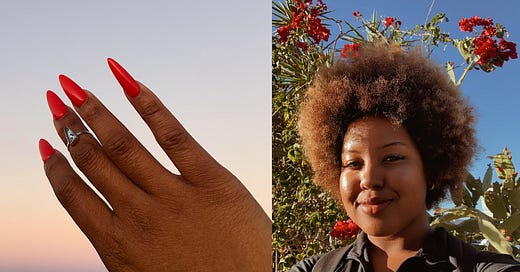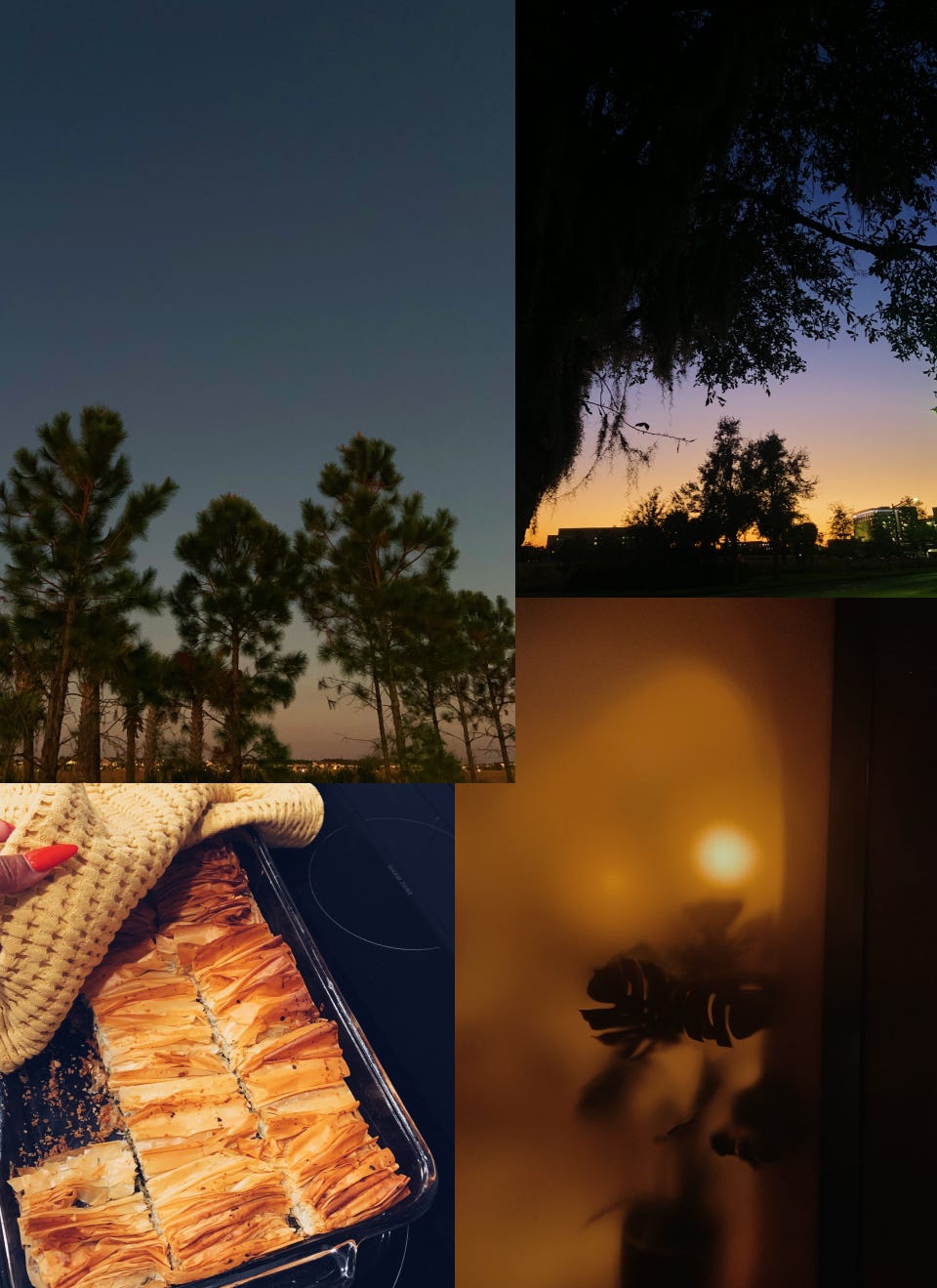Owning our climate futures
November feels, Storytelling's role in climate change, How BIPOC creatives can shape climate action, An invitation to my upcoming masterclass on how to build your climate portfolio with purpose.
I hope you actually made time to rest and enjoy this past weekend (especially my USA readers who had a holiday last week).
We didn’t do much cooking this Thanksgiving. Instead of cooking at home, we opted to dine out, and it was lovely. We had time to rest, break bread, play games, and just enjoy each other’s company rather than being at the kitchen stove or sink all day.
For me, this long weekend was a mashup of family time, a bit of work, and reflection.
November was long and short all at once. I celebrated a new year with the perfect shade of red nails and cried with gratitude for the amount of love that surrounds me. I took inventory of my ambitions, and took accountability for where I’m at and where I’m headed. I welcomed the change in season and fished winter sweaters from storage. I never thought I’d say this, but I’m loving the shift in temperature. Sunlight is fleeting, and as usual, I’m savoring every last drop. I am literally chasing sunsets; climbing too many steps to reach the rooftop just in time to see the hot orange melt into the skyline. I’m crossing wheat fields by foot just to blush at the blue-purple ombre of dusk. I am pulling over on the side of the road to marvel at how a still lake mirrors the pastel sky. I’m spending lots of time in my notebook sipping warm drinks to keep me cozy while I write, plan, and prep for my upcoming free masterclass on 12/9, How to Build Your Climate Portfolio with Purpose.
While grabbing sweaters from storage I came across two of my favorite cookbooks: In BiBi’s Kitchen (the recipes and stories of grandmothers from the Eight African Countries that touch the Indian Ocean) by Hawa Hassan, and First Generation (recipes from my Taiwanise- American home) by Frankie Gaw.
Both cookbooks are gorgeously told from culturally-informed perspectives that paint a wider picture of cultural preservation, ancestral reverence, and community appreciation through food.
The storytelling in each book got me thinking about the types of cultural stories I love to see in climate communications - the grounded, inviting, and vibrant kind that celebrate our customs and heritage, while also educating and inspiring us to preserve what we’ve been given.
Preserving our customs, sharing our stories for generations to come, and allowing ourselves to be seen and heard is part of what makes this living so rich.
Stories are what drive us to know who we are, and they help us co-create where we’re headed.
Who Is Telling The Story?
When it comes to the stories we consume about climate change, how we see ourselves reflected (or not) in those stories has a huge impact on how we perceive the issue and solution.
Who tells us about climate change, what details they include, when and where the story reaches us, and how the story makes us feel, all influences how we engage in climate action. This quote from Harmony Labs give language to why reaching new climate audiences is crucial:
Entering the next frontier of climate communications requires knowing which audiences haven’t been reached, where they gather, what drives them, and how we reach them. Spoiler alert: these audiences aren’t the usual suspects, and they’re not reading news, which is where most climate content currently lives. We need to meet the un- and under-engaged where they already are. This means storytellers must leverage the incredible power of all cultural content to connect with audiences on climate.”
- Harmony Labs' How to Reach New Climate Audiences
In 2021, when I realized my friends, colleagues, and various communities were mostly lost on what to do about climate change, I decided to do something about it. I committed to learning more and contributing my creative skillset to the climate movement. I pivoted my entire creative career to become an answer to this question:
How do we as BIPOC creatives engage our families, friends, and community about climate through our work?
There are countless ways to approach this necessary work of building new climate stories that include our cultural realities, our lived experiences, and our communities.
We need diverse artists addressing climate in nuanced, intersectional ways.
You don’t have to completely change your career focus to climate like I did, but to figure out how you want to show up as a creative in climate, you need generative spaces to explore what that could look like. That’s why…
I’m making space for BIPOC creative professionals to own their role in climate action.
In this masterclass I will teach you how to:
Clarify your values and incorporate them into your portfolio
Communicate your vision and purpose through your work
Identify what area of climate your creativity will best serve
Start building a climate portfolio that reflects your POV
And more! I’m pumped to teach this live on Monday, December 9th at noon EST. But if you cannot make it live, no problem. The replay will be emailed to registrants. Reserve your spot today before the week rolls by and you forget!
How to begin owning your role in climate storytelling as a creative:
If you are a BIPOC creative professional currently not working in climate who wants to start, but you’re not sure where to begin, my masterclass is the perfect place to quell your curiosity.
If you’ve made it this far into the letter, I have a small treat for ya! Keep reading for a taste of what I’ll dive deeper into in my masterclass, How to Build your Climate Portfolio with Purpose. Below I’m sharing three strategies I believe every creative needs to thrive in climate communications. These are not just vague concepts, they’re key lessons from lived experience I’ve developed over the years.
1. Own your story first
Your background and personal story are powerful assets - identifying and expressing your answer to "why climate now" and “why me” can transform your creative work. Climate communications thrives on reaching audiences in ways that resonate with their values. Understanding what makes your story yours is the first step to creating work that resonates with your people.
2. Lead with your creative strengths
Your unique skills and cultural perspective are needed in the climate movement. But you gotta get know what you are good at, and what you’re able to deliver on. Reflect on your creative skills that could make an impact in the climate space - whether it's visual storytelling, strategic design, or crafting compelling narratives. These are the strengths that will set your work apart.
3. Build community to fuel resilience
The climate career space can be challenging for artists, especially for BIPOC creatives breaking into it with no prior experience in social impact. Surrounding yourself with a community that gets it can make all the difference. In my upcoming live virtual masterclass, we’ll dive deeper into finding allies and building a network that keeps you energized and motivated. P.s: if you’re looking for a positive, and wider social impact community, I have a few free membership vouchers to The Bloom, where I’ve been a Climate Leader for the past few months. Message me if you’d like one.
YOUR TURN!
I want to hear from you (seriously). Do you address climate change in your creative work? Why or why not? Share where you’re at in the comments!
3 Awe ‘Tings
a short list of awe-inspiring content to help you through your week
📖 In Bibi’s Kitchen - Gorgeous cookbook honoring the wisdom of African grandmothers. Chef’s kiss!
🍎 Get Redy Farm - my friend Nai Vasha is starting an all red regenerative farm in Hawaii and could use your support!
🎵 B.P.E song by Anaiis - (Brown People Everywhere) I’m still listening to Anaiis’s new album with Grupo Cosmos on repeat. These visuals eat.











